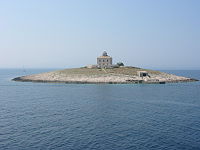Tag:place=island
 |
| Description |
|---|
| Any piece of land that is completely surrounded by water and isolated from other significant landmasses. |
| Group: places |
| Used on these elements |
| Requires |
|
| Useful combination |
| See also |
| Status: approved |
| Tools for this tag |
|
An island is any piece of land that is completely surrounded by water and isolated from other significant landmasses.
How to map
Island in the sea
Draw a closed way counterclockwise along the coastline of the island (water is always on the right hand side). Then add the tags:
Island in waterway or lake
Island within lakes or rivers should be mapped using multipolygon relations.
Multipolygon representing water will have the following topology:
- The way for shore of lake or river (outer border of water) should have the role outer.
- The way for the shore of island (inner border of water) should be given the role inner.

It's possible to create a second multipolygon representing the island with the following topology:
- The way for the shore of island (outer border of island) should be given the role outer.
So, the same way for the shore of island will have different roles in different multipolygons.
A single closed way for the shore of the island can be used directly instead of creating a multipolygon.
If the island has a name, it can be tagged with: place=island and name=*.
You can specify the land-use, or by what it is covered with a natural=* or landuse=* tag.
Large island
Islands with coastlines having more than 2000 nodes will require a multipolygon relation to be created containing the place=island and name=* ... tags etc. See this example of the Isle of Kerrera.
When to use place=island
An island is any piece of land that is completely surrounded by water and (hydrologically) isolated from other significant landmasses;
an island is still an island (or if smaller than than 1 square kilometre tagged as place=islet ) when:
- it is connected to the shore with bridges (not dams, that would make the island a peninsula);
- the water surrounding the island is a river or canal
- the distance between two shores of the mainland is filled with more land than water
For example see the Ile de Cite ("City Island") in Paris, which at its widest spans more than 2/3rd of the width between the banks of the mainland and is connected to both banks with 10 bridges, and is commonly regarded as an island (and is tagged an Islet in OSM because of the 1 km² criterium) :

When to avoid place=island
Small island
A small island (![]() Islet), with maximum area of 1 km², and only a few buildings (or none), located near a bigger island or the mainland, is drawn like a big island, but tagged with
Islet), with maximum area of 1 km², and only a few buildings (or none), located near a bigger island or the mainland, is drawn like a big island, but tagged with place=islet instead of place=island. Example: ![]() Beginish
Beginish
if an island is in the middle of the sea and far away of other islands, it may be tagged as "island". Example: ![]() Wake Island
Wake Island
See also: Differentiation between Island and Islet (List with examples)(de).
Group of islands
If you are not mapping one island, but a group of islands, use place=archipelago instead.
Peninsula
If the piece of land you are mapping is not completely surrounded by water, use natural=peninsula instead.
Submerged sometime or all time
Consider using natural=bare_rock/rock/sand/shoal + tidal=yes, or natural=wetland + wetland=tidalflat for area that only emerge from water during low tide, and use natural=reef or subsea=* for area that always stay below water surface. was:place=island/islet might be useful in indicating features that used to be an island but is no longer an island now, so as to avoid mistagging by other contributors.
Rendering hints
If you place an island on dry land, do not expect water to automatically appear around the island.
You need to map water area.
Standard layer
Adding this tag to an island will place an italicized label on it.
The openstreetmap.org Standard layer uses a different method to render coastlines. It takes up to a day before changes to the coastline are seen in the tiles. For more details, see Coastline.
See also
- Original proposal for this feature
place=isletfor hamlet sized or smaller islandsplace=archipelagofor archipelagosnatural=peninsulafor peninsulastraffic_calming=islandfor highway traffic calming islands
